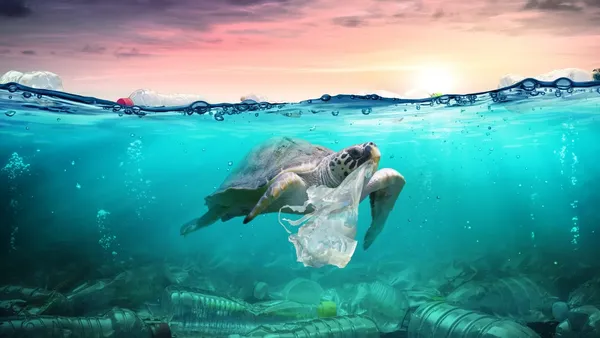Eye For Film >> Movies >> Plastic Earth (2023) Film Review
Plastic Earth
Reviewed by: Jennie Kermode

Before you read this review, take a moment to observe your surroundings. How much plastic is there within five metres of you? There’s almost certainly some on the device on which you’re reading this. If you’re at home, there’s likely to be plastic in your furniture, carpets, curtains and any number of small gadgets, containers and ornaments. If you’re commuting, it’s likely that the vehicle you’re riding in has plastic fittings. More likely than not, there’s also plastic in your clothes – and plastic inside your body.
Like the product it addresses, this documentary may look cheap and overproduced, but it has the potential to be very useful. The problem which it addresses will already be familiar to many viewers – we set out to create something indestructible and surprise, we can’t destroy it. As it breaks down into smaller and smaller fragments it only becomes more destructive, not just to cut sea turtles, like the one in the promotional images, but to pretty much everything living. The film spends only a short part of its running time reminding us about the damaged ecosystems, the plastic-triggered illnesses and the damage done by endocrine-disrupting phthalates before moving on to look at a subject less frequently explored: the search for solutions.

It’s presented by Rob Riggle, who is photographed from unnecessary angles so that some of the time he seems to be talking to an unseen third party, a curious phenomenon which pops up from time to time in low budget documentaries whose crews value making an impression over getting the job done. It focuses on concerned mother Janice Overbeck, who co-directs with Jack Winch, yet whilst this type of framing is usually associated with a certain type of emotive polemic, the scientific approach here is actually pretty solid. It’s backed by extensive interviews with researchers and entrepreneurs, and although the film tends to skip about a bit, not always successful in establishing a cohesive narrative thread, it’s full of interesting information.
First and foremost, there’s a breakdown of what plastic actually is, with simple, accessible infographics explaining the different types, how they’re produced and how – if – they can be dealt with after use. There’s a popular myth, even within environmentalist circles, that no plastics are truly biodegradable, so it’s good to see that tackled here (obvious though the truth may be to anyone who knows a bit of chemistry). Viewers who are new to the subject will immediately be better equipped to make environmentally friendly choices.
In exploring these options, the film looks at the history of PHAs and the way that their production was affected by a historic increase in sugar prices. It also looks at the new generation of PHAs based on food waste, and at one company’s efforts to pull carbon directly out of the air for use in plastic production, though it’s realistic about the need to spend years on safety testing before a new plastic can be brought to market (they’re barely referenced here, but there are plenty of ugly examples of what can happen when this isn’t done).
There’s an exploration of issues around recycling which again avoids spending too much time on familiar problems before moving on to solutions. Plastic Bank, for instance, is addressing the distribution issues around plastic recovery in the poorest parts of the world by treating it as a currency and paying people locally, directly, for the materials they can gather and feed back into production. European viewers will be amused – and perhaps a little shocked – by the revelation that the US has only just discovered the concept of bottle deposits, but at least it’s a step in the right direction.
Some of the most interesting material looks at efforts to recover plastic floating in the ocean, or to prevent it from reaching the ocean in the first place by intercepting it in river mouths, as Indonesia, Malaysia, the Dominican Republic and Vietnam are now doing. There’s some ingenious work showcased here, which may appeal to prospective investors or simply make viewers despairing of the state of the world feel that there is room for hope.
Interviews aside, the footage focused on these different projects is not itself very informative. The camera roves around scientific and industrial environments observing whatever looks complicated or shiny, relevant or (more often) not. Odd editing decisions add to the problem. The film is still worth watching because it gets such a good grip on its subject, but in light of the urgency thereof, it would have been nice to be able to recommend it more highly.
Reviewed on: 06 Feb 2023
















